
The Meaning of
"Mechanical"
Keywords
elongation,
modulus,
strength,
stress,
toughness
So What's "Mechanical" About a Property?
If you've been reading much of The Macrogalleria, you'll notice that we talk a lot about polymers as being "strong" and "tough" or maybe even "ductile". Strength, toughness, and ductility are all mechanical properties. But what do these words really mean? How do we measure how "strong" a polymer is? What is the difference between a "strong" polymer and a "tough" polymer? This page is dedicated to sorting out all these matters.
Strength
Strength is a mechanical property that you should be able to relate to, but you might not know exactly what we mean by the word "strong" when we're talking about polymers. First, there is more than one kind of strength. There is tensile strength. A polymer has tensile strength if it is strong when one pulls on it like this:
Tensile strength is important for a material that is going to be stretched or under tension. Fibers need good tensile strength. The image below shows tensile testing of a vinyl ether polymer, isotactic poly(isobutyl vinyl ether).
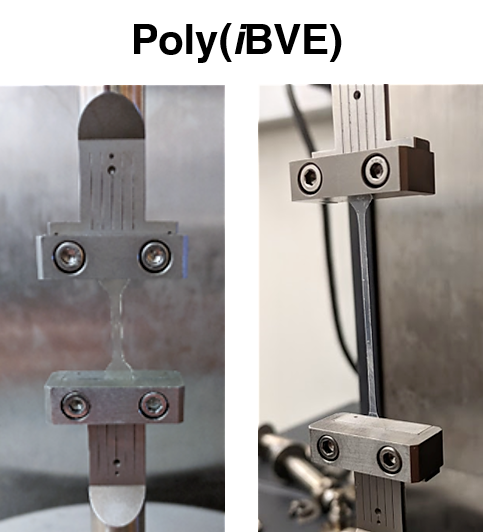
Then there is compressional strength. A polymer sample has compressional strength if it is strong when one tries to compress it, like this:
Concrete is an example of a material with good compressional strength. Anything that has to support weight from underneath has to have good compressional strength.
There is also flexural strength. A polymer sample has flexural strength if it is strong when one tries to bend it.
There are other kinds of strength we could talk about. A sample torsional strength if it is strong when one tries to twist it. Then there is impact strength. A sample has impact strength if it is strong when one hits it sharply and suddenly, as with a hammer.
What is Strength?
But what does it mean to be strong? We have a very precise definition. Let's use tensile strength to illustrate. To measure the tensile strength of a polymer sample, we take the sample and we try to stretch it just like in the picture above. We usually stretch it with a machine such as an Instron. This machine simply clamps each end of the sample, then, when you turn it on it stretches the sample. While it is stretching the sample, it measures the amount of force (F) that it is exerting. When we know the force being exerted on the sample, we then divide that number by the cross-sectional area (A) of our sample. The answer is the stress that our sample is experiencing.

Likewise, one can imagine similar tests for compressional or flexural strength. In all cases, the strength is the stress needed to break the sample.
Since tensile stress is the force placed on the sample divided by the cross-sectional area of the sample, tensile stress, and tensile strength as well, are both measured in units of force divided by units of area, usually N/cm2. Stress and strength can also be measured in megapascals (MPa) or gigapascals (GPa). It's easy to convert between the different units, because 1 MPa = 100 N/cm2, 1 GPa = 100,000 N/cm2, and of course 1 GPa = 1,000 MPa.
Other times, stress and strength are measured in the old English units of pounds per square inch, or psi. If you ever have to convert psi to N/cm2, the conversion factor is 1 N/cm2 = 1.45 psi.
Elongation
But there's more to understanding a polymer's mechanical properties than merely knowing how strong it is. All strength tells us is how much stress is needed to break something. It doesn't tell us anything about what happens to our sample while we're trying to break it. That's where it pays to study the elongation behavior of a polymer sample. Elongation is a type of deformation. Deformation is simply a change in shape that anything undergoes under stress. When we're talking about tensile stress, the sample deforms by stretching, becoming longer. We call this elongation, of course.
Usually we talk about percent elongation, which is just the length the polymer sample is after it is stretched (L), divided by the original length of the sample (L0), and then multiplied by 100.

There are a number of things we measure related to elongation. Which is most important depends on the type of material one is studying. Two important things we measure are ultimate elongation and elastic elongation
Ultimate elongation is important for any kind of material. It is nothing more than the amount you can stretch the sample before it breaks. Elastic elongation is the percent elongation you can reach without permanently deforming your sample. That is, how much can you stretch it, and still have the sample snap back to its original length once you release the stress on it. This is important if your material is an elastomer. Elastomers have to be able to stretch a long distance and still bounce back. Most of them can stretch from 500 to 1000 % elongation and return to their original lengths without any trouble.
Modulus
Elastomers need to show high elastic elongation. But for some other types of materials, like plastics, it usually better that they not stretch or deform so easily. If we want to know how well a material resists deformation, we measure something called modulus. To measure tensile modulus, we do the same thing as we did to measure strength and ultimate elongation. This time we measure the stress we're exerting on the material, just like we did when we were measuring tensile strength. We slowly increase the amount of stress, and then we measure the elongation the sample undergoes at each stress level. We keep doing this until the sample breaks. Then we make a plot of stress versus elongation, like this:
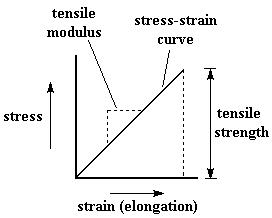
There are times when the stress-strain curve isn't nice and straight, like we saw above. For some polymers, especially flexible plastics, we get odd curves that look like this:

The slope isn't constant as stress increases. The slope, that is the modulus, is changing with stress. In a case like this we usually that the initial slope as the modulus, as you can see in the stress-strain curve above.
In general, fibers have the highest tensile moduli, and elastomers have the lowest, and plastics have tensile moduli somewhere in between fibers and elastomers.
Modulus is measured by calculating stress and dividing by elongation, and would be measured in units of stress divided by units of elongation. But since elongation is dimensionless, it has no units by which we can divide. So modulus is expressed in the same units as strength, such as N/cm2.
Toughness
That plot of stress versus strain can give us another very valuable piece of information. If one measures the area underneath the stress-strain curve, colored red in the graph below, the number you get is something we call toughness.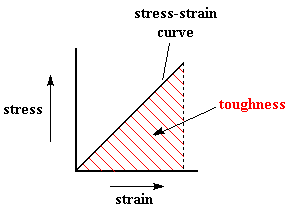
How is toughness different from strength? From a physics point of view, the answer is that strength tells how much force is needed to break a sample, and toughness tells how much energy is needed to break a sample. But that doesn't really tell you what the practical differences are.
What is important is knowing that just because a material is strong, it isn't necessarily going to be tough as well. We'll look at some more graphs to show this. Take a look at the one below, the one with three plots, one blue, one red, and one pink.
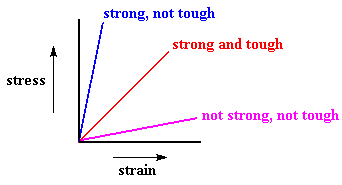
On the other hand, the red plot is a stress-strain curve for a sample that is both strong and tough. This material is not as strong as the sample in the blue plot, but the area underneath its curve is a lot larger than the area under the blue sample's curve. So it can absorb a lot more energy than the blue sample can.
So why can the red sample absorb so much more energy than the blue plot? Take a look at the two. The red sample elongates a lot more before breaking than the blue sample does. You see, deformation allows a sample to dissipate energy. If a sample can't deform, the energy won't be dissipated, and will cause the sample to break.
In real life, we usually want materials to be tough and strong. Ideally, it would be nice to have a material that wouldn't bend or break, but this is the real world. You have to make trade-offs. Take a look at the plots again. The blue sample has a much higher modulus than the red sample. While it's good for materials in a lot of applications to have high moduli and resist deformation, in the real world it's a lot better for a material to bend than to break, and if bending, stretching or deforming in some other way prevents the material from breaking, all the better. So when we design new polymers, or new composites, we often sacrifice a little bit of strength in order to make the material tougher.
Mechanical Properties of Real Polymers
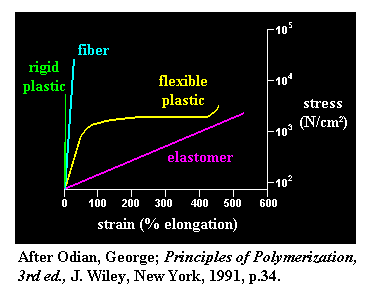 We've been talking abstractly for a long time, now, so it would probably
be a good idea to talk about which polymers show which kinds of mechanical
behavior, that is, which polymers are strong, which are tough, and so
forth.
We've been talking abstractly for a long time, now, so it would probably
be a good idea to talk about which polymers show which kinds of mechanical
behavior, that is, which polymers are strong, which are tough, and so
forth.
This is why there's a big graph on your right. It compares typical stress-strain curves for different kinds of polymers. You can see in the green plot that a rigid plastics such as polystyrene, poly(methyl methacrylate) or polycarbonate can withstand a good deal of stress, but they won't withstand much elongation before breaking. There isn't much area under the stress-strain curve at all. So we say that materials like this are strong, but not very tough. Also, the slope of the plot is very steep, which means that it takes a lot of force to deform a rigid plastic. (I suppose that's what it means to be rigid, now doesn't it?) So it's easy to see that rigid plastics have high moduli. In short, rigid plastics tend to be strong, resist deformation, but they tend not to be very tough, that is, they're brittle.
Flexible plastics like polyethylene and polypropylene are different from rigid plastics in that they don't resist deformation as well, but they tend not to break. Of course, the ability to deform is what keeps them from breaking. Initial modulus is high, that is it will resist deformation for awhile, but if enough stress is put on a flexible plastic, it will eventually deform. You can try this at home with a piece of a plastic bag. If you try to stretch it, it will be very hard at first, but once you've stretched it far enough it will give way and stretch easily. The bottom line is that flexible plastics may not be as strong as rigid ones, but they are a lot tougher.
It is possible to alter the stress-strain behavior of a plastic with additives called plasticizers. A plasticizer is a small molecule that makes plastics more flexible. For example, without plasticizers, poly(vinyl chloride), or PVC for short, is a rigid plastic. Rigid unplasticized PVC is used for water pipes. But with plasticizers, PVC can be made flexible enough to use to make things like inflatable swimming pool toys.
Fibers like KevlarTM , carbon fiber and nylon tend to have stress-strain curves like the aqua-colored plot in the graph above. Like the rigid plastics, they are more strong than tough, and don't deform very much under tensile stress. But when strength is what you need, fibers have plenty of it. They are much stronger than plastics, even the rigid ones, and some polymeric fibers, like KevlarTM, carbon fiber and ultra-high molecular weight polyethylene have better tensile strength than steel.
Elastomers like polyisoprene, polybutadiene and polyisobutylene have completely different mechanical behavior from the other types of materials. Take a look at the pink plot in the graph above. Elastomers have very low moduli. You can see this from the very gentle slope of the pink plot, but you probably knew this already. You already knew that it is easy to stretch or bend a piece of rubber. If elastomers didn't have low moduli, they wouldn't be very good elastomers, now would they?
But it takes more than just low modulus to make a polymer an elastomer. Being easily stretched is not much use unless the material can bounce back to its original size and shape once the stress is released. Rubber bands would be useless if they just stretched and didn't bounce back. Of course, elastomers do bounce back, and that's what makes them so amazing. They have not just high elongation, but high reversible elongation.
Going Beyond Tensile Properties
Ok, this is all well and good, but this little discussion which types of polymers have which mechanical properties has focused mostly on tensile properties. When we look at other properties, like compressional properties or flexural properties things can be completely different. For example, fibers have very high tensile strength and good flexural strength as well, but they usually have terrible compressional strength. They also only have good tensile strength in the direction of the fibers.

Pool Your Strengths
We've talked a lot about how some polymers are tough, while others are strong, and how one often has to make trade-offs when designing new materials. One may have to sacrifice strength for toughness for example. But sometimes we can combine two polymers with different properties to get a new material with some of the properties of both. There are three main ways of doing this, and they are copolymerization, blending, and making composite materials.An example of a copolymer that combines the properties of two materials is spandex. It is a copolymer containing blocks of elastomeric polyoxyethylene and blocks of a rigid fiber-forming polyurethane. The result is a fiber that stretches. Spandex is used to make stretchy clothing like bicycle pants.
High-impact polystyrene, or HIPS for short, is an immiscible blend that combines the properties of two polymers, styrene and polybutadiene. Polystyrene is a rigid plastic. When mixed with polybutadiene, an elastomer, it forms a phase-separated mixture which has the strength of polystyrene along with toughness supplied by the polybutadiene. For this reason, HIPS is far less brittle than regular polystyrene.
In the case of a composite material, we're usually using a fiber to reinforce a thermoset. Thermosets are crosslinked materials whose stress-strain behavior is often similar to plastics. The fiber increases the tensile strength of the composite, while the thermoset gives it compressional strength and toughness.
References
Odian, George; Principles of Polymerization, 3rd ed., J. Wiley, New York, 1991.Jang, B. Z.; Advanced Polymer Composites: Principles and Applications, ASM International, Materials Park, OH, 1994.

|
Return to Level Three Directory |

|
Return to Macrogalleria Directory |